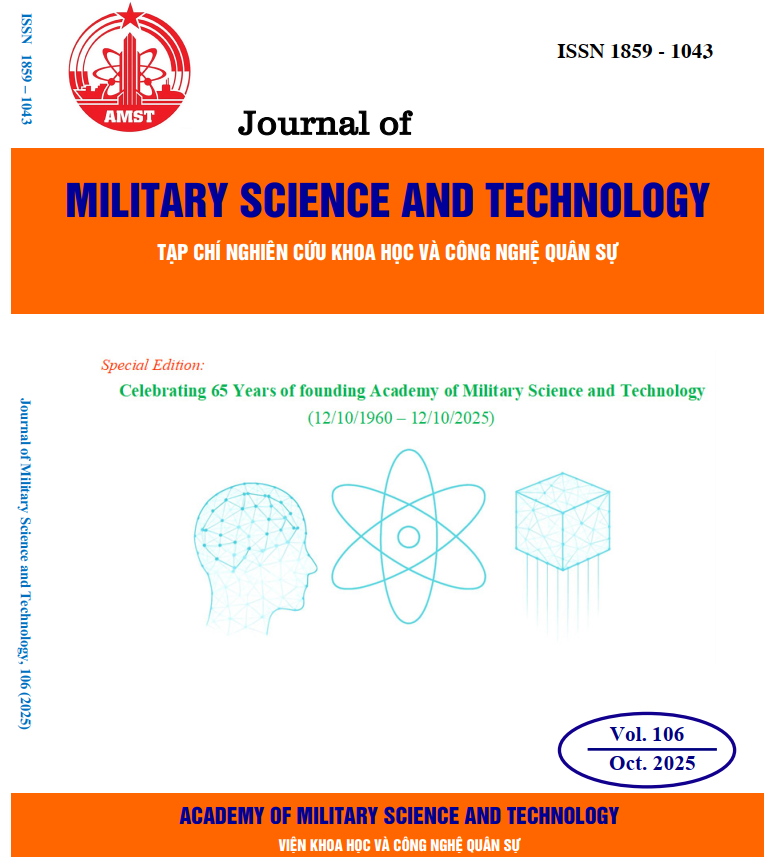A method for designing pixelated camouflage patterns for forest terrain backgrounds
199 viewsDOI:
https://doi.org/10.54939/1859-1043.j.mst.106.2025.121-128Keywords:
Pixelated camouflage pattern; Evaluation metrics; PSNR; Histogram intersection.Abstract
Camouflage is a critical component of modern military operations, enabling objects to blend visually into their surroundings. Traditional disruptive patterns used widely from the 1970s to early 2000s are increasingly replaced by pixelated camouflage. This study proposes a design method for pixelated camouflage patterns tailored to forest terrain. Effectiveness is evaluated using Peak Signal-to-Noise Ratio (PSNR) and Histogram Intersection (HI), which assess visual and color similarity. Results show the designed patterns resemble forest backgrounds in color and texture, indicating practical potential.
References
[1]. Q. Jia et al, “Design and evaluation of digital camouflage pattern by spot combination,” Multim. Tools Appl., vol. 79, no. 29, pp. 22047-22064, (2020). DOI: https://doi.org/10.1007/s11042-020-09002-5
[2]. S. Choudhary, R. Sharma, “Terrain Specific Real-Time Pixelated Camouflage Texture Generation and its Impact Assessment,” Def. Sci. J., vol. 72, no. 6, pp. 824-835, (2022). DOI: https://doi.org/10.14429/dsj.72.17599
[3]. X. Wei et al, “A novel method for automatic camouflage pattern synthesize,” IEEE Access, vol. 9, pp. 67559-67568, (2021). DOI: https://doi.org/10.1109/ACCESS.2021.3077258
[4]. Santos, “Camouflage US Marine Corps combat utility uniform: pattern, fabric, and design,” United States Patent 10/967,885, (2009).
[5]. M. Friskovec and H. Gabrijelcic, “Development of a procedure for camouflage pattern design,” Fibres & Textiles in Eastern Europe, vol. 18, no. 4, p. 81 (2010).
[6]. M. D. Witting, D. Goyal, “Normal pupillary size in fluorescent and bright light”, Ann Emerg Med, vol. 41, no. 2, pp. 247-250, (2003). DOI: https://doi.org/10.1067/mem.2003.8
[7]. Nguyen Ngoc Son et al, “Method for designing camouflage patterns blend to the natural backgrounds,” Journal of Military Science and Technology, vol. 92, pp. 121-129, (2023).
[8]. M. Ahmed, R. Seraj, SMS Islam, “The k-means Algorithm: A Comprehensive Survey and Performance Evaluation,” Electronics, vol. 9, no. 8, p. 1295, (2020). DOI: https://doi.org/10.3390/electronics9081295
[9]. F. Xue et al, “Design of digital camouflage by recursive overlapping of pattern templates,” Neurocomputing, vol. 172, pp. 262-270, (2016). DOI: https://doi.org/10.1016/j.neucom.2014.12.108
[10]. M. Friskovec, H.Gabrijelcic and B. Simoncic, “Design and evaluation of a camouflage pattern for Slovenian urban environment, ” JIST, vol. 54, no. 2, pp. 20507-1, (2010). DOI: https://doi.org/10.2352/J.ImagingSci.Technol.2010.54.2.020507
[11]. N. T. Lam et al, “Developing a method to generate an adaptive real-time camouflage pattern based on electro-chromic active devices,” Journal of Military Science and Technology, vol. 99, pp. 78-88, (2024). DOI: https://doi.org/10.54939/1859-1043.j.mst.99.2024.78-88
[12]. C. J. Lin et al, “Developing a similarity index for static camouflaged target detection,” Imaging Sci. J., vol. 62, no. 6, p. 341, (2014). DOI: https://doi.org/10.1179/1743131X13Y.0000000057
[13]. Z. Wang, A. C. Bovik, “A universal image quality index,” IEEE Signal Process. Lett., vol. 9, no. 3, pp. 81-84, (2002). DOI: https://doi.org/10.1109/97.995823
[14]. Tran Tien Bao et al, “A method to evaluate camouflage effectiveness by computer simulation,” Journal of Military Science and Technology, vol. 90, pp. 119-126, (2023).
[15]. Do Xuan Doanh et al, “Multicriteria evaluation method applied in the field of camouflage,” Journal of Military Science and Technology, Special Issue on FEE, pp. 154-163, (2022). DOI: https://doi.org/10.54939/1859-1043.j.mst.FEE.2022.154-163
[16]. C. J. Lin et al, “Developing and evaluating a target-background similarity metric for camouflage detection,” PLoS One, vol. 9, no. 2, p. e87310 (2014). DOI: https://doi.org/10.1371/journal.pone.0087310
[17]. S. M. Lee et al, “Evaluation of image similarity by histogram intersection,” Color Res. Appl., vol. 30, no. 4, pp. 265-274, (2005). DOI: https://doi.org/10.1002/col.20122
[18]. Y. Zheng, M. Agnani, and M. Singh, “Identification of grey sheep users by histogram intersection in recommender systems,” in Advanced Data Mining and Applications: 13th International Conference, ADMA 2017, Singapore, November 5–6, 2017, Proceedings 13, Springer International Publishing, pp. 148–161 (2017). DOI: https://doi.org/10.1007/978-3-319-69179-4_11







